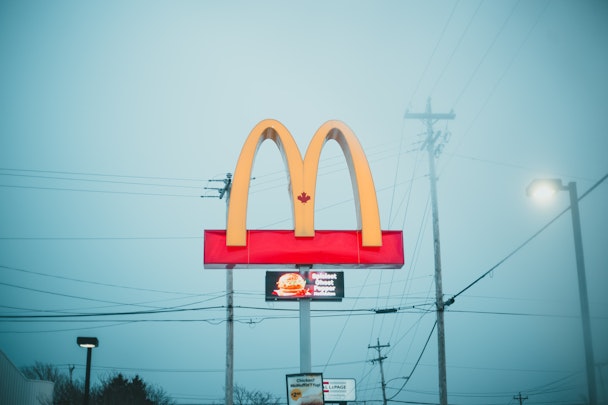3 brands that have grown global gracefully: McDonald’s, Apple and Google
International expansion can make or break a brand. How do they stay on the right side of that line? For our Globalization Deep Dive, Lydia Chenhall of DRPG puts it down to consistency, innovation and evolution.

What do the global behemoths McDonald’s, Apple and Google have in common? / Erik Mclean via Unsplash
DRPG started in a shed just over 40 years ago and now lives and works in over 30 countries. Growth, expansion and a global presence have not damaged its culture but supercharged it. All it takes is finding the formula to achieve global success with grace. The biggest brands across the globe were once just a budding idea. But what exactly was their formula?
Advertisement
McDonald’s: adaptation and consistency
Beloved fast food chain McDonald’s is known around the world thanks to its iconic golden arches and affordable, tasty food. But how has it grown global so comfortably? It has to be the easily-recognizable branding and effortless ability to adapt to its surroundings, all while offering the service and quality that’s come to be expected from it.
Look at it this way: when you’re lost abroad, the sight of that golden M shining in the distance brings relief, because you know what to expect.
McDonald’s has sprouted 38,000 restaurants in 100 countries. The same menu won’t work for every country, because local cuisines are incredibly different. While the menu can differ depending on where you are, branding remains consistent. This is why it remains a household name.
On top of its beloved Big Macs and McFlurries, there’s a whole range of different menu items depending on which country you visit; in Italy you can try the scrumptious panzerotti, and in Canada you can even have the iconic poutine. Subtly adapting your offering to your demographic without altering your brand is one of the most important things a business needs to implement as times change.
Advertisement
Apple: stylish innovation
Steve Jobs created a company with an offering like no other. It’s likely that either you or someone you know owns at least one Apple product. But Apple almost didn’t make it this big. It wasn’t until Steve Jobs realized Apple had become stagnant in its innovation (and that design aesthetics were just as important as the tech) that Apple found itself at the forefront of tech innovation.
Founded in 1976, Apple made a name for itself with the iconic iMac, bashing through beige-colored competition with various color options. Apple’s luck changed when it released the iPod in 2001, which impacted the way we consumed music. Later, the iPhone is considered by many as the first modern smartphone in 2007. Apple has dominated the market since.
Apple continues to change the landscape of technology with new and improved models that boast sleek, stylish aesthetics and increased performance. It doesn’t seem to be slowing down any time soon.
Suggested newsletters for you
Google: useful evolution
Let’s be honest, you don’t ‘search the web.’ You ‘Google it.’ Launched in 1998, Google is a brilliant example of finding success by providing consumers with something useful, accessible and competitive.
Other search engines have come and gone since the internet began, and Google continues to reign supreme. On average, there are 5.4bn Google searches a day; as of August 2022, 92% of all search queries were done through Google.
Why? Because Google’s algorithm and SEO practices are constantly evolving with searcher intent. It’s been around long enough that it’s instantly recognizable and is usually the default browser on the majority of laptops and phones outside of Apple products, so it certainly has the edge over its competitors. Most importantly, though, it’s trustworthy.
Google is now so advanced in its personalization that we usually find exactly what we’re searching for on the first page. It remains the search engine of choice while attention span and patience have dwindled down to just eight seconds, thanks to super speedy internet and, ultimately, Google’s facilitation and evolution of consumer habits.
How can you make it global?
Perfectly demonstrated by these iconic brands, not only is it important to adapt and evolve with consumer habits, it’s important to maintain who you are as a company. Wishy-washy branding and an inconsistent tone of voice will turn consumers off; how are they supposed to trust you if you’re not even able to demonstrate a stable identity?
Build up that trust through recognizable branding and consistent consumer interaction, and make sure your offering is still worth their while. Going global isn’t easy. It takes hard work and dedication, but who doesn’t love a challenge?
For more on what marketers and their partners need to do to succeed on a global level, check out The Drum’s Globalization Deep Dive.
Content by The Drum Network member:

DRPG
DRPG is one of the longest established, trusted and uniquely integrated communication and production specialists, famous for making anything possible as we connect...
Find out more
